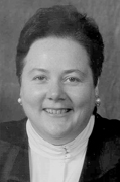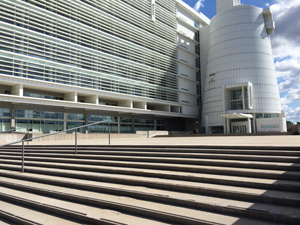|
|
Judge Kathleen Tomlinson, who is presiding over the dispute about the proposed eruv Jewish religious boundary in the Hamptons, expressed dismay at a hearing Feb. 26 that the five-year old battle may have years to go.
The battle has already cost Southampton, Westhampton Beach, Quogue and Jewish People Opposed to the eruv more than $1 million in outside legal costs. The towns have been threatened with large sums in fines and penalties should they lose.
Tomlinson, magistrate judge for the U.S. District Court for the Eastern District of New York, invited “this small army of lawyers” to her chambers in Central Islip rather than arrange a phone conference. Thirty-six pages of notes on the meeting are available for public inspection.
When Robert Sugarman, attorney for the East End Eruv Assn., which is pursuing the action against the towns, said, “this case is now in its fifth year,” Tomlinson remarked, “God help us all,” according to the notes.
She later said that the slew of legal actions has been “officially” reported to her superiors in Washington, D.C., since they are more than three years old “so I have my own incentive for trying to get a resolution here in the end as well.”
In-Person Viewing Required
The notes have to be viewed in person at the Court’s offices. Residents of the three towns, college and high school students, and reps of the libraries involved should all troop to Islip and view the notes since it is a huge crack in the wall of silence that marks the costly and interminable eruv legal case. It’s Cases 11-CV-213, 11-CV-252, and 1B-CV-4810.
|
|
Battling the EEEA’s charges wastes funds that could be spent providing affordable housing for the low-income service people, many of them minorities, who work the estates in the towns.
The issue doesn’t belong in the courts at all since it involves religious dogma. “Keep the church out of the state and the state out of the church,” comedian Lewis Black correctly told a WHB audience March 27.
Local media, with the exception of the Southampton Press and its 27east.com website, have mostly ducked the story. This includes the New York Times which last wrote about it Feb. 4, 2013. NYT reporter Nicholas Confessore is the son of Quogue Library president Lynda Confessore.
Local libraries, amazingly, are very skittish about this issue. None will host a discussion of it although the American Library Assn. is urging libraries to “promote community dialogue on controversial issues” and encourage “diverse points of view” in order to remain relevant.
Near universal access of people to the web and its unbounded research capabilities has put a big dent in what libraries have to offer. Many libraries strive for usefulness by having dozens of computer terminals.
The Hampton Bays Library wants taxpayers to borrow $1 million for a new roof, insulation and repairs to it physical plant.
What the library needs is repairs to its commitment to be an “educational resource” for the community. The truth about many topics can only be obtained through vigorous public discussion. Timidity and turf-protecting are enemies of this.
Three New York City public libraries are seeking $1.4 billion over the next decade for their physical plants. They must accept that people carry devices in their pockets that access much of what is in libraries and a lot more.
Eruv Lawyers Told to “Focus”
Tomlinson told the lawyers to “focus on getting things back on track.” They included Sugarman and Yehudah Buchweitz of Weil, Gotshal & Manges, for EEEA; Erica Weisgerber, Debevoise & Plimpton, for Verizon New York; Zachary Murdock, Lazer Aptheker Rosella & Yedid, Long Island Lighting Assn.; Brian Sokoloff, Sokoloff & Stern, WHB; Maureen Liccione, Jaspan Schlesinger, Southampton, and David Arnsten and Josh Shlierman, Quogue.
“I really do want to get these cases back on track and move them forward so we’re not sitting here next year saying, now we’re in the sixth year, etc.,” she said. She also noted there are “emotional issues” besides legal issues involved.
Emotions can be the enemy of reason.
Definition of “Sign,” Church vs. State Are Issues
The tangle of legal issues has resulted in an outpouring of billions of words, one filing alone being 70 gigabytes according to Tomlinson (about 25 million pages assuming 1,000 words a page).
Quogue and Southampton both have laws against signs on utility poles. The validity of those laws in relation to eruv markers has yet to be determined at the New York State level. That decision could be months away. The EEEA contends that the markers, called “lechis,” are not signs at all.
Is There and Eruv in WHB?
The question of whether there is an eruv in WHB came up.
A search by 27east.com of 45 utility poles licensed for eruv markers in WHB by LIPA and Verizon found no such markers.
The website of the Hampton Synagogue on May 2 said “The Eruv Is Up.” The website also says “No state or federal court has ever supported opposition to an eruv.” However, U.S. District Court D in New Jersey, presided over by Judge William Bassler, in 2001 ordered the eruv in Tenafly dismantled, saying “public property should not be permanently allocated to a religious purpose.”
It was overturned in 2002 by an Appeals Court headed by Thomas Ambro. We fault that decision because it compared the powerful symbols of an eruv with such “signs” on utility poles as directional signals, lost animal notices, and ribbons affixed by students. It was an apples/oranges comparison.
The Ambro decision is a good example of the verbal overload that is swamping the courts. The 16,981-word decision contains links to 238 precedent cases all of which have their own links. The word total is in the billions, possibly trillions, over a matter that does not deserve one second of a court’s time.




 Husch Blackwell Strategies has added FleishmanHillard alum Michael Slatin as a principal in its public affairs group.
Husch Blackwell Strategies has added FleishmanHillard alum Michael Slatin as a principal in its public affairs group. Rory Cooper, a veteran Republican operative and policy specialist, has joined Teneo’s Washington office as senior managing director in its strategy & communications practice.
Rory Cooper, a veteran Republican operative and policy specialist, has joined Teneo’s Washington office as senior managing director in its strategy & communications practice. Brian Fallon, who served as national press secretary for Hillary Clinton’s 2016 presidential run, is signing on next month as Vice President’s Kamala Harris’ campaign communications director.
Brian Fallon, who served as national press secretary for Hillary Clinton’s 2016 presidential run, is signing on next month as Vice President’s Kamala Harris’ campaign communications director. TikTok is nothing more than a Chinese propaganda tool that poses “a grave threat to America’s national security and, in particular, impressionable children and young adults,” say two Congressmen who want the platform registered as a foreign agent.
TikTok is nothing more than a Chinese propaganda tool that poses “a grave threat to America’s national security and, in particular, impressionable children and young adults,” say two Congressmen who want the platform registered as a foreign agent. Public Strategies Washington has added Abbie Sorrendino, a former aide to now Senate Majority Leader Chuck Schumer.
Public Strategies Washington has added Abbie Sorrendino, a former aide to now Senate Majority Leader Chuck Schumer.


 Have a comment? Send it to
Have a comment? Send it to 
No comments have been submitted for this story yet.